Infrared therapy can be a game-changer for diabetic wound recovery. It works by enhancing circulation, promoting tissue healing, and reducing inflammation. You'll find that this non-invasive treatment improves blood flow and accelerates collagen synthesis, leading to faster healing of diabetic foot ulcers. Studies show significant reductions in ulcer size and pain relief when using infrared therapy. With a good safety profile and minimal side effects, it seamlessly complements traditional treatments. Interested in how to implement it effectively or track progress? There's more to discover about harnessing this therapy for ideal results.
Overview of Infrared Therapy
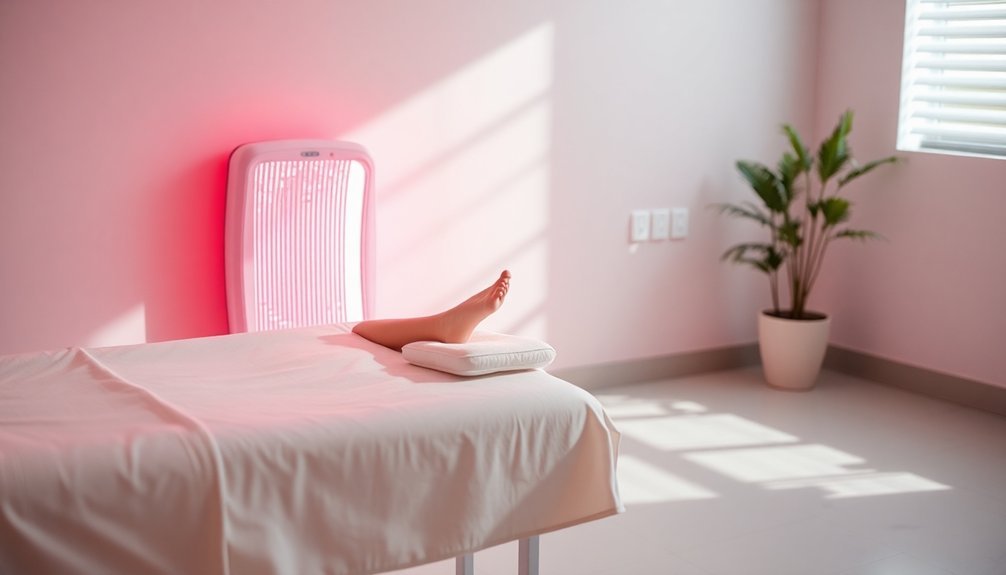
Infrared therapy is a cutting-edge treatment that harnesses infrared light to penetrate deep into body tissues, promoting healing and recovery. Often referred to as red light therapy or low-level light therapy (LLLT), it uses infrared radiation with wavelengths ranging from 760nm to 100,000nm.
Near-infrared wavelengths (600-1000nm) are the most commonly utilized for their therapeutic effects, while far-infrared (FIR) wavelengths (1500nm to 0.1 mm) serve specific treatment purposes. One of the key benefits of infrared therapy is its effectiveness in alleviating chronic pain conditions such as arthritis and fibromyalgia. It enhances muscle recovery, reduces soreness after workouts, and improves circulation by increasing blood flow, which delivers essential oxygen and nutrients to tissues.
This therapy also promotes overall wellness by enhancing the body's natural healing processes and reducing inflammation, providing a soothing effect on sore muscles and joints. Importantly, infrared therapy is safe and non-invasive, with minimal to no side effects. Unlike treatments that use harmful UV rays, it requires no downtime after sessions and is well-tolerated by most individuals, making it a versatile option for various health conditions. Additionally, far-infrared rays can penetrate up to 1.5 inches beneath the skin, maximizing therapeutic benefits.
Mechanisms of Action
The mechanisms of action underlying infrared therapy's effectiveness in diabetic wound recovery are multifaceted and impactful.
By harnessing the power of infrared light, you're facilitating several essential processes that lead to enhanced healing.
- Increased Circulation: Infrared therapy boosts blood flow, enhances capillary formation, and helps deliver essential nutrients to the wound site.
- Cellular Stimulation: It stimulates cellular proliferation and migration, particularly fibroblasts, promoting collagen synthesis critical for wound closure. Additionally, photobiomodulation (PBM) has been shown to improve wound healing by reducing oxidative stress and enhancing tissue regeneration.
- Infection Control: This therapy enhances phagocytosis, effectively clearing dead cells and bacteria, while reducing inflammation and fostering a healthier cellular environment.
- Pain Reduction: By increasing endorphin release, it alleviates pain in the wound area, creating a more comfortable healing experience.
Clinical Evidence and Research
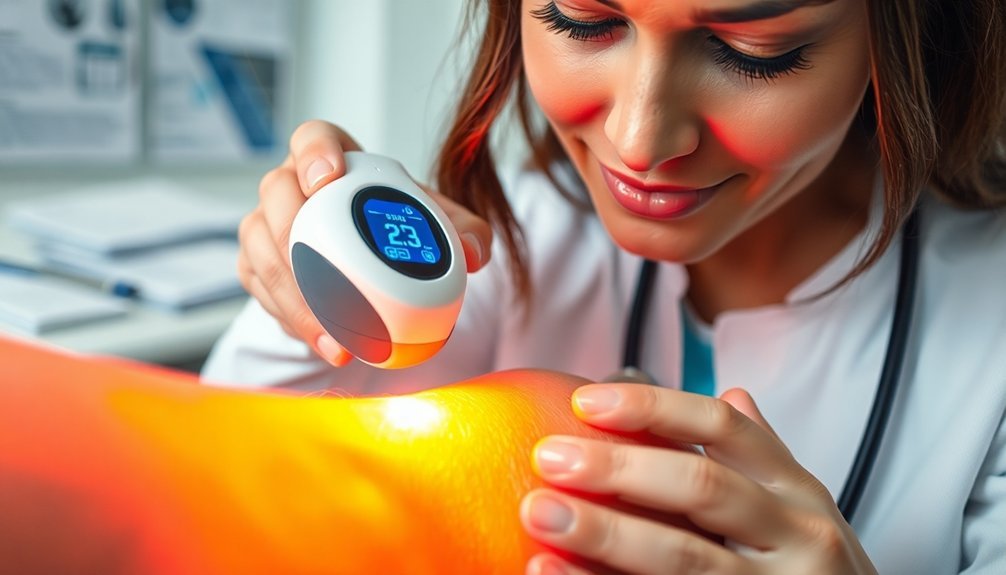
While many therapies target diabetic wound recovery, clinical evidence increasingly supports the effectiveness of infrared therapy. In a randomized controlled trial of 52 patients with diabetic foot ulcers, infrared light therapy combined with routine dressings showed a considerable reduction in ulcer size compared to dressings alone, with sizes dropping from 893.56 mm to 375.30 mm.
Similarly, a sham-controlled trial of 27 patients treated with Monochromatic Infrared Energy (MIRE) resulted in improved limb sensitivity, reduced pain, and better balance.
Photobiomodulation (PBM) also demonstrates promise, as several studies highlight increased healing rates for diabetic foot ulcers when paired with conventional treatments. Importantly, infrared therapy often compares favorably to laser therapy, being just as effective, if not more so, for wound healing and symptom relief. Additionally, a study showed that the average ulcer duration was more than four weeks among participants, highlighting the chronic conditions faced by diabetic patients.
However, research has its limitations. Future studies need to address the effects of skin color on PBM efficacy and implement randomized, placebo-controlled designs to guarantee findings are robust.
As the body of evidence grows, infrared therapies may become a staple in diabetic wound recovery protocols, enhancing patient outcomes considerably.
Benefits for Diabetic Patients
How can infrared therapy transform the healing journey for diabetic patients? This innovative treatment offers numerous benefits that speed up recovery and improve overall health. You can expect a significant enhancement in wound healing, better blood circulation, reduced pain, and a lower risk of complications.
- Improved Wound Healing: Infrared therapy accelerates wound recovery by boosting collagen synthesis and blood vessel formation, so your wounds can heal much faster.
- Enhanced Blood Flow and Circulation: This therapy stimulates nitric oxide production, improving blood flow to the affected areas, which helps deliver essential nutrients and oxygen to your wounds.
- Pain Reduction and Inflammation Control: Infrared therapy lowers inflammation and pain, creating a more favorable environment for healing while decreasing discomfort from diabetic neuropathies.
- General Health and Complication Prevention: Regular use can help manage blood sugar levels and reduce the risk of serious complications, like amputations, enhancing your quality of life.
Incorporating infrared therapy into your treatment plan could be a game-changer, making wound recovery less intimidating and more successful for you.
Application and Treatment Protocol
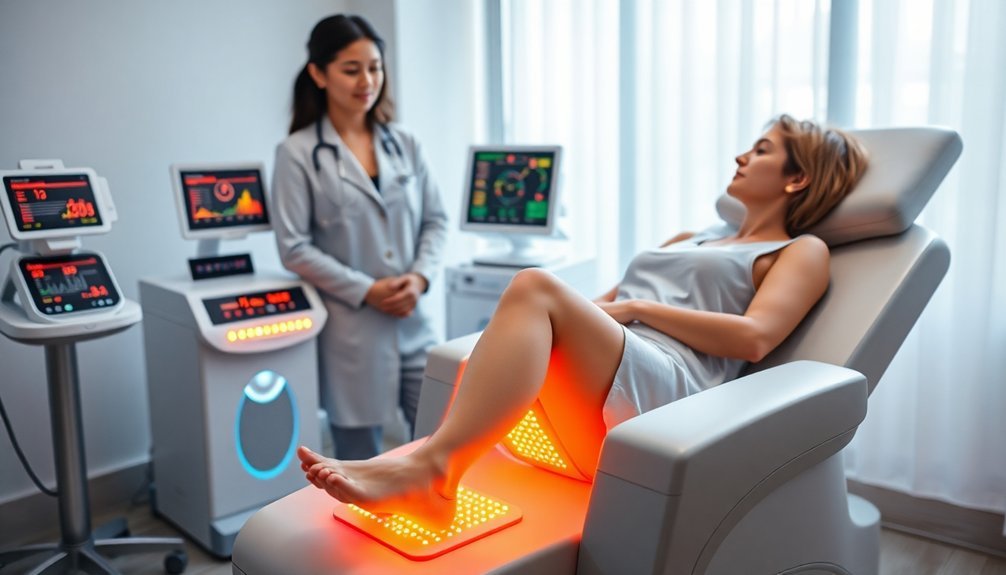
Infrared therapy offers a systematic approach to healing diabetic wounds, combining specific treatment parameters for maximum effectiveness. To begin, select effective wavelengths, such as 633 nm, 660 nm, 808 nm, or 904 nm.
For fluence, aim for 2.35 J/cm² for diabetic wounds and 4.71 J/cm² for burns, administering treatment three times weekly. Utilize a power density of 0.1 W/cm² for ideal results, and maintain treatment frequency of three times a week or daily over one to two weeks.
When applying the therapy, use low-intensity laser irradiation directly on the wound, making sure you're at the right angle and distance—about 45-50 cm for smaller lamps. Prepare the skin beforehand, checking thermal sensations and shielding the eyes.
Turn on non-luminous lamps 15 minutes prior to treatment for peak efficacy. Adjust lamp positioning or resistance to control intensity.
Remember to monitor the patient's comfort throughout the process and to reflect on combining infrared therapy with other treatments. Keep track of wound progression and adjust parameters as required for ideal healing.
This structured approach guarantees you provide effective care for diabetic wound recovery.
Safety and FDA Clearance
Safety in infrared therapy for diabetic wound recovery is a top priority. Generally, this therapy is considered noninvasive and safe for patients.
Studies indicate no significant adverse effects when utilizing infrared radiation for wound healing, as it works to reduce oxidative stress and inflammation, which can hinder recovery. However, it's crucial to monitor patients for any immune reactions or irritation during treatment.
Here are some key points regarding its safety and FDA clearance:
- The HealthLight™ infrared therapy device received FDA marketing clearance in 2011 for wound care.
- The FDA emphasizes preclinical safety assessments and clinical trials to guarantee efficacy.
- Infrared therapy has an A-level recommendation from the Association for the Advancement of Wound Care for treating unresponsive pressure ulcers.
- Clinical evidence shows statistically significant improvements in wound healing and tissue regeneration with infrared therapy.
Recommended Treatment Parameters
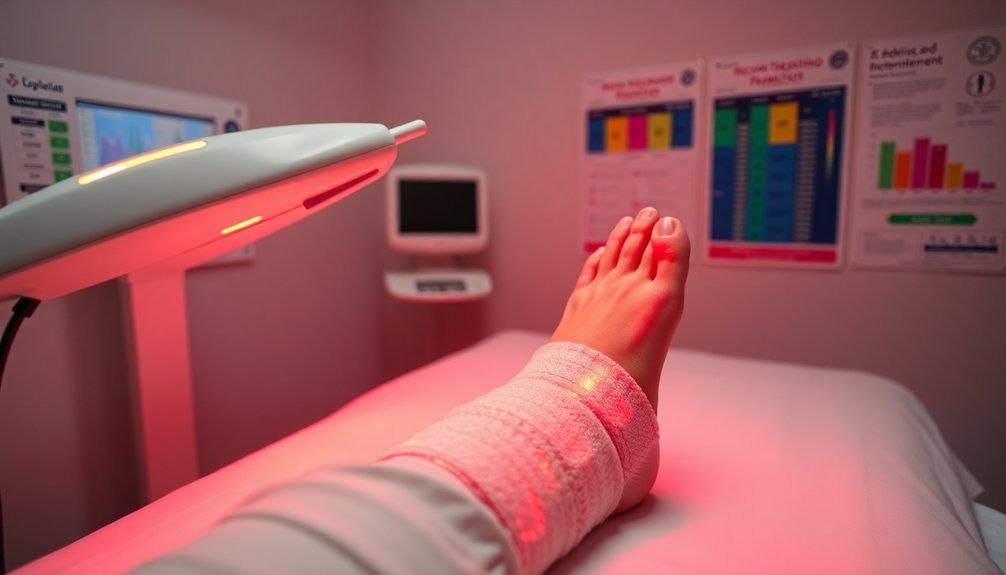
When considering the ideal parameters for infrared therapy in diabetic wound recovery, it's essential to focus on specific wavelengths, fluences, and treatment frequencies that enhance healing.
For best results, aim for wavelengths in the range of 630-830 nm, as studies show these effectively promote wound healing and reduce inflammation. Specifically, 633 nm tends to deliver positive outcomes, especially in diabetic and burn wounds.
In terms of fluence, targeting around 2.35 J/cm² for diabetic wounds and 4.71 J/cm² for burn wounds, with treatment occurring three times a week, is recommended.
Be cautious with the fluence, as both too high and too low levels can hinder cellular responses.
Treatments should ideally span four to six weeks to observe significant improvements.
During this period, you may choose between continuous or pulsed laser irradiation, as each can have unique effects on healing.
Practical Tips for Implementation
With the right treatment parameters in place, implementing infrared therapy for diabetic wound recovery can effectively enhance healing.
To guarantee a smooth process, follow these practical tips:
- Prepare the Patient: Position them comfortably to minimize discomfort. Expose the treatment area while explaining the procedure and its effects to alleviate anxiety.
- Set Up Equipment: Use non-luminous infrared generators and keep the lamp at a right angle to maximize penetration. Maintain an ideal distance based on the lamp's power (60-75 cm for large lamps, 45-50 cm for smaller ones).
- Safety First: Avoid treating areas with skin conditions, tumors, or infections. Conduct a skin examination beforehand and shield the eyes if necessary.
- Monitor Comfort: Be vigilant for any adverse reactions, like excessive erythema or discomfort, during treatment. Adjust the lamp's position or intensity as needed.
Monitoring Progress and Adjustments
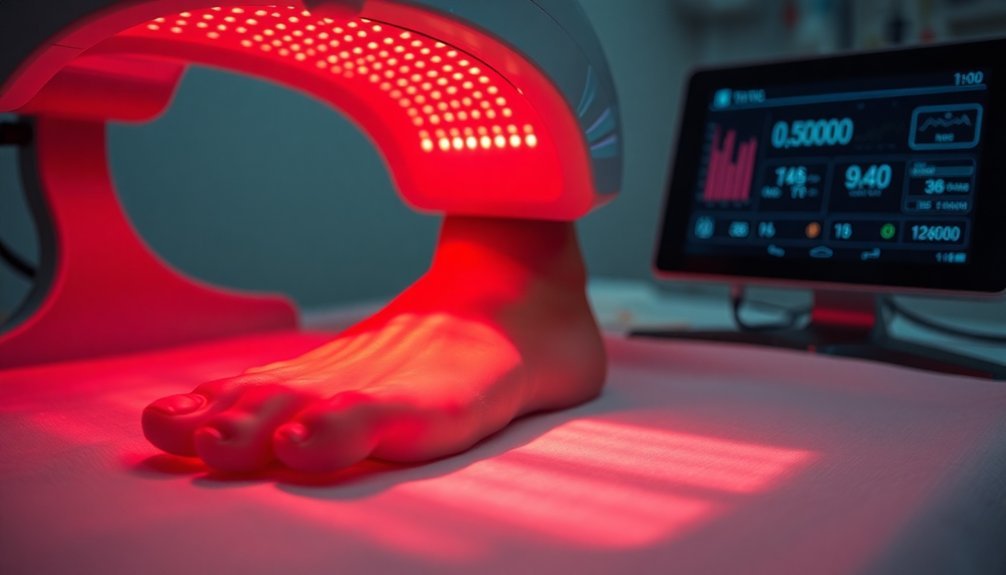
Effective monitoring of progress in infrared therapy for diabetic wound recovery is essential for optimizing treatment outcomes. One key method is monitoring thermal asymmetry between your affected and unaffected feet using infrared thermography. This technique involves capturing daily thermographic images during hospitalization to measure the mean plantar temperature difference.
However, note that it's not particularly useful for tracking diabetic foot infections while in the hospital.
At home, you can utilize handheld infrared skin thermometers to detect early signs of inflammation. Taking measurements on the sole of your foot each morning and evening, then logging these temperatures, allows for proactive intervention.
Research shows that this home monitoring considerably reduces diabetic foot complications.
In combination with conventional dressings, infrared radiation therapy accelerates healing of diabetic ulcers. It promotes blood flow to the wound area, improving granulation tissue formation.
As you monitor your healing, keep an eye on your hospitalization duration, antibiotic adjustments, and any signs of infection, including swelling or redness. Regular follow-up and assessment of inflammatory markers will also strengthen your recovery process, ensuring you're on the right path.
Integrating Therapy With Conventional Treatments
Integrating infrared therapy with conventional wound care methods enhances diabetic wound recovery greatly. By combining these approaches, you can markedly improve blood circulation and reduce pain and inflammation in affected areas.
The synergy between infrared therapy and other treatments creates a holistic strategy to manage your condition effectively.
Consider the following benefits of integrating infrared therapy into your routine:
- Increased Circulation: Infrared energy dilates blood vessels, promoting better nutrient and oxygen delivery to the wound site.
- Pain Relief: Infrared therapy has shown a 67% pain reduction after 60 days, particularly for neuropathy-related discomfort.
- Enhanced Healing: Using infrared therapy can complement conventional methods, especially in cases where they've previously failed.
- Supportive Care: Combining infrared therapy with physical therapy can further enhance nerve health and mobility.
You'll find that embracing this combined approach not only accelerates healing but also leads to a considerable improvement in overall quality of life.
You can work closely with your healthcare provider to customize a treatment plan that suits your unique needs and maximizes recovery outcomes.
Future Directions in Research
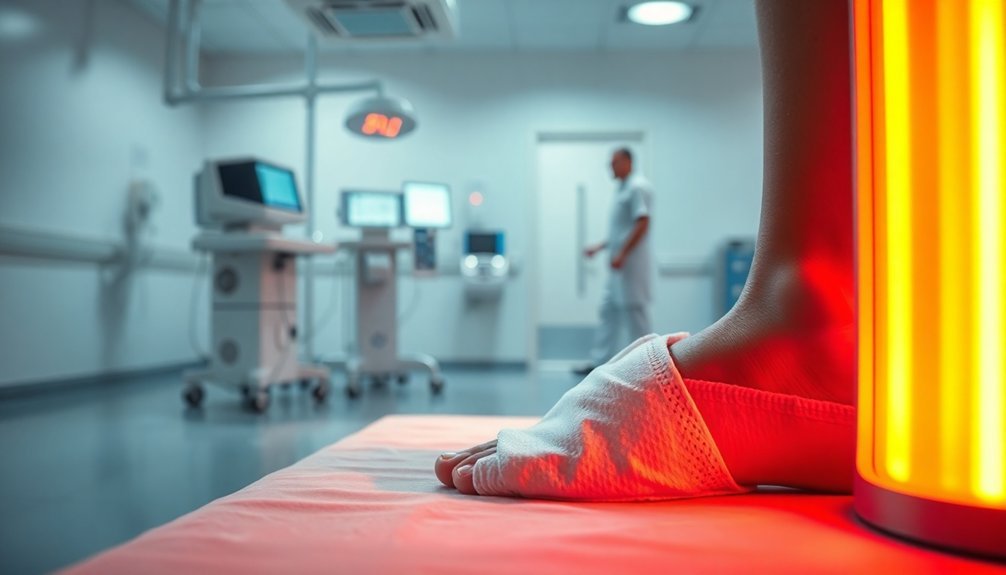
Exciting opportunities lie ahead in the exploration of infrared therapy for diabetic wound recovery. Researchers are honing in on the specific mechanisms and biological effects of various infrared wavelengths. For instance, you could benefit from studies focusing on far-infrared (FIR) and near-infrared (NIR) therapies, each demonstrating unique penetration depths and cellular responses. This research promises to uncover how specific wavelengths can enhance collagen synthesis and reduce inflammation effectively.
Moreover, future clinical trials will likely explore larger populations to confirm the long-term efficacy of infrared therapies. You can expect advancements in device development too, aiming to optimize wavelength, intensity, and treatment duration, making it easier for you to use at home.
The investigation into combination therapies also holds significant potential. By merging FIR and NIR treatments, researchers might uncover synergistic effects that enhance healing even further.
Additionally, integrating infrared therapy with traditional wound care approaches could lead to thorough treatment regimens. All these avenues are set to transform how diabetic wound recovery is managed, paving the way for innovative solutions to improve patient outcomes.
Frequently Asked Questions
How Long Does a Typical Infrared Therapy Session Last?
A typical infrared therapy session lasts about 20 minutes. However, it can vary based on specific treatment protocols. You might find shorter sessions of 10-15 minutes work better for ideal results tailored to your needs.
Can Infrared Therapy Cause Skin Irritation or Sensitivity?
Yes, infrared therapy can cause skin irritation or sensitivity, especially if you have sensitive skin or certain medical conditions. Starting with shorter sessions and consulting a healthcare provider can help mitigate these effects.
Is Infrared Therapy Suitable for All Types of Wounds?
Infrared therapy's suitable for many wound types, including surgical, chronic, and acute wounds. It promotes healing by improving blood flow and reducing inflammation. However, consult a healthcare professional to verify it's appropriate for your specific situation.
How Quickly Can Patients Expect to See Results?
You can typically expect to see significant improvements in wound healing after about five weeks of infrared therapy, with many patients experiencing complete healing during this period, especially when treatments are applied consistently three times a week.
Are There Any Contraindications for Using Infrared Therapy?
Yes, there are contraindications for using infrared therapy. If you have skin damage, active cancer, poor circulation, or certain medical conditions, you should avoid it. Always consult a healthcare professional before starting any therapy.
In Summary
Incorporating infrared therapy into your diabetic wound recovery plan could greatly enhance healing. By understanding its mechanisms and benefits, you can effectively use this treatment alongside conventional methods. Remember to monitor your progress and make adjustments as needed to optimize results. As research continues to evolve, staying informed will help you leverage the latest advancements for your health. Embrace the synergy of infrared therapy, and take charge of your healing journey today!

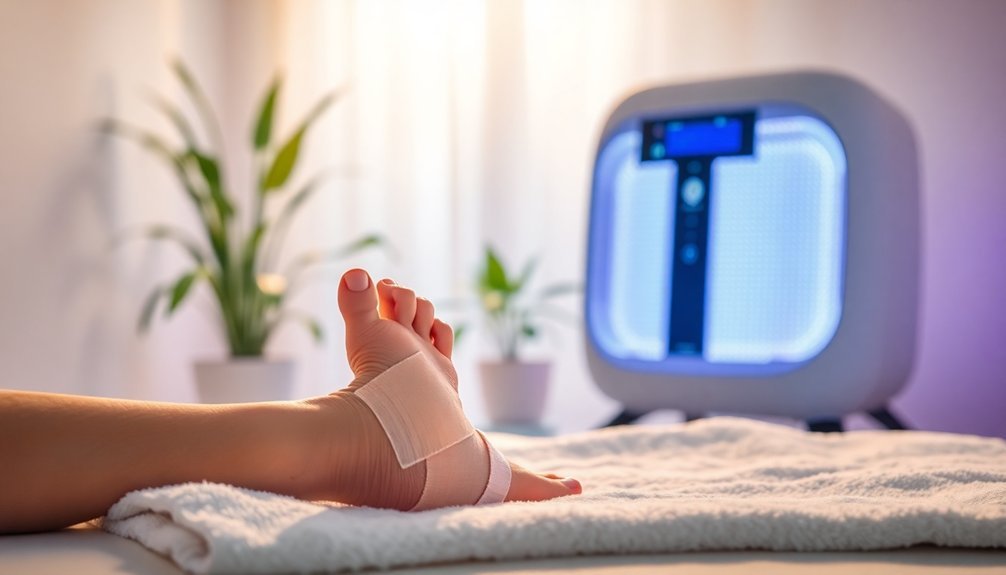



Leave a Reply